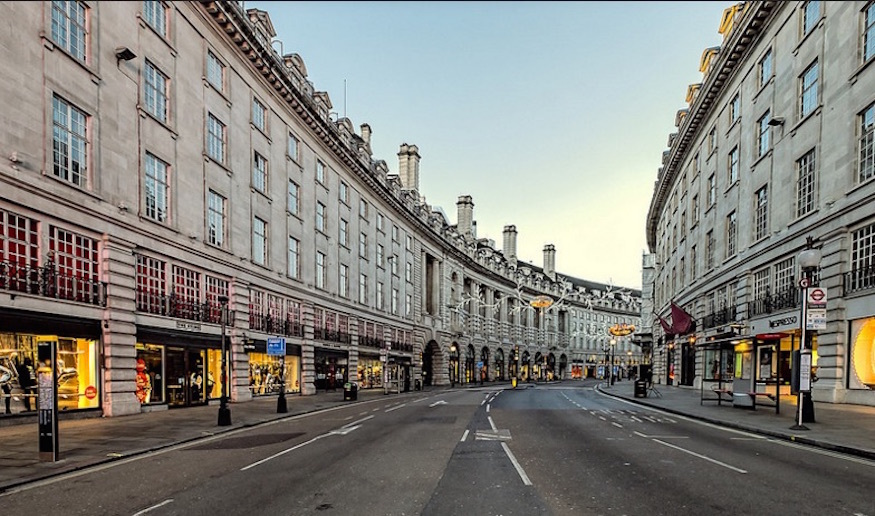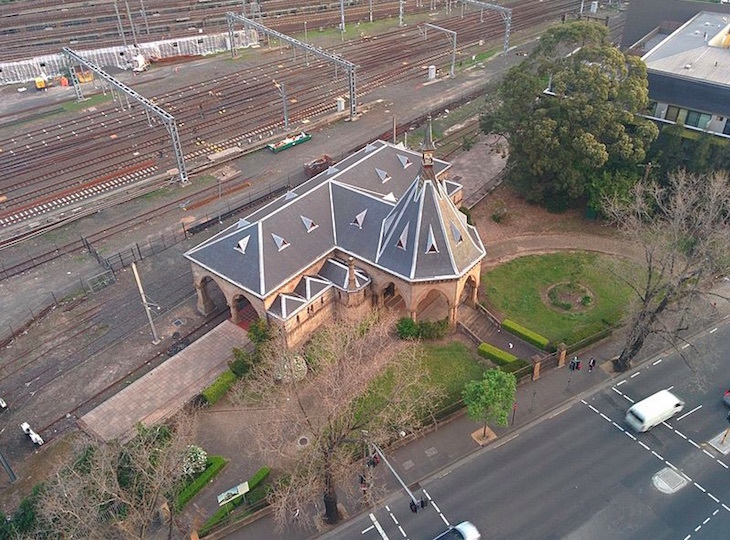
1. It's named after the Prince Regent
...who later became King George IV. He ruled as Prince Regent for 10 years (1810-1820) while his father George III was too ill to go about his kingly business.
In this time, the Prince Regent lived at Carlton House (which stood where Carlton House Terrace now stands, but was demolished in 1829). He was planning to build himself a nice new palace in Regent's Park — which at the time was considered the countryside outside of London — and wanted a new road built to join his two palaces.
As we've already covered, Regent Street is mostly owned by the Crown Estate to this day.
2. It's all listed
Every building on Regent Street is Grade II listed. Collectively they form the Regent Street Conservation Area (PDF), which also encompasses other neighbouring streets
The original Regent Street was designed by John Nash, although the only surviving Nash building to this day is the church All Souls Langham Place. As well as being intended as a royal thoroughfare, it was also the world's first purpose built shopping centre.
"It will quite eclipse Napoleon." - the Prince Regent on seeing Nash's plans in 1811.
Many of the buildings were rebuilt between 1904 and 1925, when larger department stores (including Liberty of London) began moving in and the existing buildings were deemed unsuitable for modern purposes in terms of size or layout.
During the development, restrictions were still in place to keep the buildings all uniform, including the use of Portland Stone on exteriors, and the restriction on buildings being five storeys tall. Architects including Richard Norman Shaw, Reginald Blomfield and Henry Tanner were involved in the redesign.

3. It's curved for a reason
So if it was designed as a direct route between two palaces, why isn't it a straight road, as was the fashion for French boulevard style roads at the time? Nash encountered land ownership issues when designing the street, so had to build round some building that already existed.
It was also thought that aligning Regent Street to go directly through Piccadilly Circus would position it too far east to draw in customers from the neighbouring wealthy area of Mayfair. As it is, Regent Street formed a barrier between the affluent Mayfair and the less respectable area of Soho.
4. Working girls
The original street featured a covered walkway known as Quadrant Colonnades. A decision was made to demolish it in 1848, due to the prevalence of 'working girls' plying their trade in the area.
5. No skyscrapers allowed
Apart from the fact that the entire area is listed which prevents any development, tall buildings are banned for another reason.
An information leaflet (PDF) about the Regent Street Conservation Area states the following:
Strategic Views: The entire Conservation Area from the south end of the Quadrant to Waterloo Place is affected by the Primrose Hill to the Palace of Westminster Strategic View.
In other words, views of the Palace of Westminster are protected in the same way that views of St Paul's Cathedral are.
6. (Not) for sale
Anyone wanting to put for sale or to let boards up on Regent Street has to get permission from Westminster City Council first. This covers houses, flats, offices and shops. Come to think of it, we don't recall ever seeing a for sale board among the luxury shops, so maybe WCC are pretty stingy about giving permission.
There are also restrictions on the sizing, colour and position of lettering that shops can have on their façades.
7. The oldest shop
...is actually a cafe. Cafe Royal opened at 68 Regent Street in 1865, staying at the same premises right through until it closed down in 2008, serving royalty and celebrities throughout this period. For four years, the property was redeveloped, and the Hotel Cafe Royal now sits on the spot.

8. The second Hamleys
For many, world-famous toyshop Hamleys is synonymous with Regent Street — but did you know the store originated elsewhere?
William Hamley founded a toyshop originally known at Noah's Ark in High Holborn in 1760, before it moved to Regent Street over a century later in 1881.
9. Late night shopping
According to Tim Moore's book, Do Not Pass Go, Regent Street was the pioneer of late night shopping in Britain. As far back as 1850, shopkeepers agreed to keep their doors open until a shocking 7pm to satisfy the retail needs of busy Londoners.

10. Christmas lights
When we recently asked for your earliest memories of London, plenty of you mentioned seeing the Christmas lights in Regent Street and Oxford Street.
The first full Christmas light display lit up Regent Street in 1954, as a result of a Daily Telegraph article which criticised London for being too dreary over the Christmas period. Prior to this, part of the street had been lit up from 1949, and Christmas trees had lined the street over the festive period in 1948.
A lack of funding meant that there was no Christmas light display in the years 1972-1977.
11. Regent Street station
No, we're not going mad, Regent Street station really does exist... in Australia:

There are plenty of other Regent Streets around the world, including in Pennysylvania, New York and Nova Scotia, although how many of them are named after our own Regent Street, we don't know.
12. The Salviati Mosaic

235 Regent Street, now home to the Apple store, was once occupied by Salviati, a glassmaking and mosaic firm hailing from the island of Murano in Venice. In 1898, the company adorned the outside of its Regent Street premises with an intricate mosaic, incorporating two lions and four coats of arms, representing the cities of London and Westminster, and the Venetian islands of Murano and Burano. The mosaics were restored in 1999 and can still be admired today.
See also:




